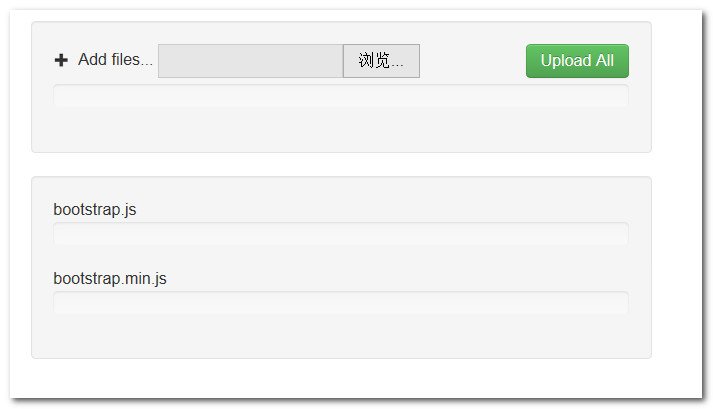最近公司一同事咨询了一个MVC项目下上传大文件时遇到的问题,问题描述如下:

MVC项目中,当上传比较大的文件时,速度非常慢,小文件基本没有影响。
如果是用传统的form表单去提交的话,会将整个文件一次性的加载到内存中然后再做保存,这个过程是相当慢的,特别是大文件,且上传文件容易受到各种因素的影响而导致上传失败,比如临时的网络故障等。

最直接的概念就是异步以及断点续传。
在处理大文件时,无法忍受因为一时的网络原因导致上传失败,从而重新再上传的烦恼。好的方法是将一个大文件分成N个小块来进行上传,即使第一次失败了,之前上传的那部分由于得到了保留,再次点击上传时,以前已经传输成功的部分就不会再次被重新写入文件。注意,第二次上传时,文件还是从0开始传输到服务器,而不能根据服务器上的文件选择性的传输片断,这部分不太好节省,有兴趣的可以研究下。
这里可以利用jQuery的相应插件来完成,它的主要功能是将文件分割成N多个小块来批量上传,参考网址:https://github.com/blueimp/jQuery-File-Upload
其实这个也非常简单,在Http头信息中有一个Conten-Range的属性,它会说明此次传递的文件内容的片断范围,我们只需要在后台解析这个范围稍加处理就可以实现。之所这么简单,是因为有了上面的jQuery 上传文件的插件,它负责将一个大文件分成N多小块进行传输,这就有了请求头中的Content-Range。
这篇文章主要参考了http://weblogs.asp.net/bryansampica/archive/2013/01/15/AsyncMVCFileUpload.aspx ,但它没有完成对文件的保存功能,我这里加了断点续传的逻辑。
效果图:

可支持同时上传多个文件

上传成功后的效果


主要是控制进展条的显示以及组件的部分参数,比如文件块大小等等。
class="brush:javascript;gutter:true;"> $(function () { $('#fileupload').fileupload({ dataType: "json", url: "/api/upload", limitConcurrentUploads: 1, sequentialUploads: true, progressInterval: 100, maxChunkSize: 10000, add: function (e, data) { $('#filelistholder').removeClass('hide'); data.context = $('<div />').text(data.files[0].name).appendTo('#filelistholder'); $('</div><div class="progress"><div class="bar" style="width:0%"></div></div>').appendTo(data.context); $('#btnUploadAll').click(function () { data.submit(); }); }, done: function (e, data) { data.context.text(data.files[0].name + '... Completed'); $('</div><div class="progress"><div class="bar" style="width:100%"></div></div>').appendTo(data.context); }, progressall: function (e, data) { var progress = parseInt(data.loaded / data.total * 100, 10); $('#overallbar').css('width', progress + '%'); }, progress: function (e, data) { var progress = parseInt(data.loaded / data.total * 100, 10); data.context.find('.bar').css('width', progress + '%'); } }); });
3. 完成断点续传后台逻辑
[HttpGet]
[HttpPost]
public HttpResponseMessage Upload()
{
// Get a reference to the file that our jQuery sent. Even with multiple files, they will all be their own request and be the 0 index
HttpPostedFile file = HttpContext.Current.Request.Files[0];
// do something with the file in this space
// {....}
// end of file doing
this.SaveAs(HttpContext.Current.Server.MapPath("~/Images/") + file.FileName, file);
// Now we need to wire up a response so that the calling script understands what happened
HttpContext.Current.Response.ContentType = "text/plain";
var serializer = new System.Web.Script.Serialization.JavaScriptSerializer();
var result = new { name = file.FileName };
HttpContext.Current.Response.Write(serializer.Serialize(result));
HttpContext.Current.Response.StatusCode = 200;
// For compatibility with IE's "done" event we need to return a result as well as setting the context.response
return new HttpResponseMessage(HttpStatusCode.OK);
}
这其中主要是通过解析Http请求头中的Content-Range属性来获知此次处理的文件片断,后续就是基本的文件操作了,没什么可说的。
private void SaveAs(string saveFilePath, HttpPostedFile file)
{
long lStartPos = 0;
int startPosition = 0;
int endPosition = 0;
var contentRange=HttpContext.Current.Request.Headers["Content-Range"];
//bytes 10000-19999/1157632
if (!string.IsNullOrEmpty(contentRange))
{
contentRange = contentRange.Replace("bytes", "").Trim();
contentRange = contentRange.Substring(0, contentRange.IndexOf("/"));
string[] ranges = contentRange.Split('-');
startPosition = int.Parse(ranges[0]);
endPosition = int.Parse(ranges[1]);
}
System.IO.FileStream fs;
if (System.IO.File.Exists(saveFilePath))
{
fs = System.IO.File.OpenWrite(saveFilePath);
lStartPos = fs.Length;
}
else
{
fs = new System.IO.FileStream(saveFilePath, System.IO.FileMode.Create);
lStartPos = 0;
}
if (lStartPos > endPosition)
{
fs.Close();
return;
}
else if (lStartPos < startPosition)
{
lStartPos = startPosition;
}
else if (lStartPos > startPosition && lStartPos < endPosition)
{
lStartPos = startPosition;
}
fs.Seek(lStartPos, System.IO.SeekOrigin.Current);
byte[] nbytes = new byte[512];
int nReadSize = 0;
nReadSize = file.InputStream.Read(nbytes, 0, 512);
while (nReadSize > 0)
{
fs.Write(nbytes, 0, nReadSize);
nReadSize = file.InputStream.Read(nbytes, 0, 512);
}
fs.Close();
}
jQuery上传组件将大文件分割成小文件上传,正好解决了.net上传文件大小问题,只要将块大小配置好即可。利用Http头信息的Content-Range来实现断点续传,即解决了性能问题也解决了用户体验。
注:
这只是我个人测试的代码,如觉的不妥,可自行修改。